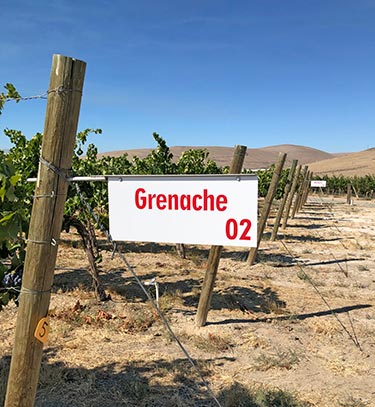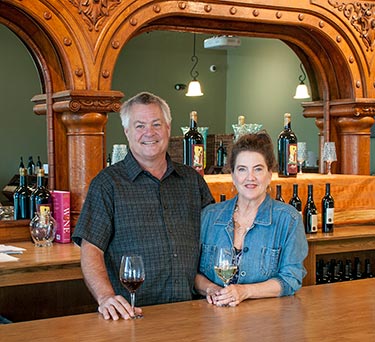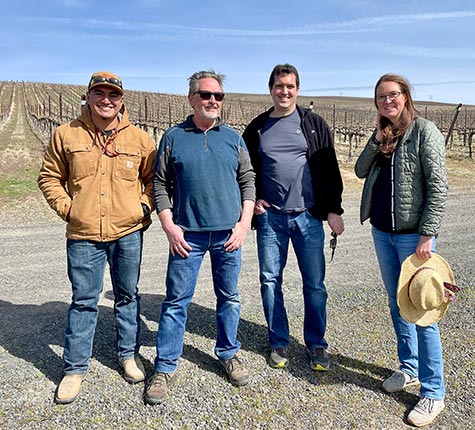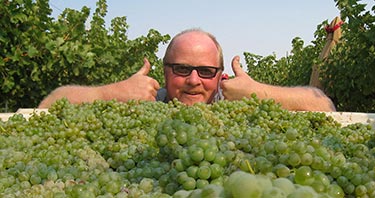Finicky by nature, this dazzling grape delivers a mighty impact that stands tall on its own

Written by John Vitale
Editor’s note: Read reviews here of 21 releases of Grenache from top Pacific Northwest producers.
IDOLIZED the world over for its appealing tangy red fruit and jammy berries amid bright current undertones with peppery spice, a demand for Washington-grown Grenache is surging among fans of Rhône varietals. In fact, winemakers here can’t get their hands on enough of this fruit.
“Grenache has been our most heavily requested grape, year in and year out, and always has been,” affirms grower Joe Hattrup, who farms 240 acres of wine grapes at Elephant Mountain and Sugarloaf Vineyard in the Rattlesnake Hills AVA. “At this point it probably always will be. Grenache has been the darling with this GSM surge.”

The light-skinned grape has established roots globally. Historically, it has been the predominant grape of Châteauneuf-du-Pape in southwestern France, a Rhône appellation renowned for its GSM red wines (Grenache-Syrah-Mourvèdre). Grenache likely originated in Spain, where it is still quite popular and goes by one of its other popular names, Garnacha.
Washington State vintners have commonly used Grenache as a key component when crafting smooth GSM Rhône-style blends. Yet the movement to showcase its illustrious beauty as a stand-alone variety is getting bigger.
Craig and Victoria Leuthold, owners of Maryhill Winery, were at the forefront of the early Grenache movement over two decades ago.
“The first vintage of Grenache we produced was in 2000. It came from the lower Columbia Gorge in the Dallesport area, and we liked it so much we had the Gunkel family put some in the ground for us near Avery, close to the winery,” says Victoria. Their current releases include a reserve bottling of Grenache and a GSM blend.
Washington’s ‘Pinot Noir’
In some circles, winemakers draw comparisons and contrasts between Pinot Noir and Grenache with respect to general similarities between overall flavor profile, structure, acidity, even food pairings.

A diehard fan of Grenache, Victoria Leuthold remembers making a connection between the two varietals just after opening Maryhill’s Goldendale tasting room back in 2001: “We had many visitors from the Oregon and Willamette area, and they would ask us if we had a Pinot to try,” recalls Victoria. “I would explain that a different climate was needed to grow Pinot Noir, but would offer a taste of our Grenache due to its lighter body weight—not unlike Pinot—and they would love it. Where some Pinot Noir can have an earthy and funky quality to it, as it’s supposed to, our Grenache stayed a bit brighter in its fruit and held beautiful acidity, giving it real natural appeal on the palate.”
Like Leuthold, winemaker and enology consultant Erica Orr is an admirer of Grenache. She has been making Grenache since 2016 under her eponymous Woodinville label, Orr Wines. Her 2022 vintage is 100% Grenache, and is a combination of Stillwater Creek and Lawrence Vineyards from the Royal Slope AVA.
“Grenache smells like red fruits—cranberry, pomegranate and raspberries—and the tannins are medium bodied. Similarly, Pinot Noir tends to be medium bodied and red-fruited as well. Both varietals can have some black tea non-fruit character,” observes Orr, adding, “One way that Grenache is very different from Pinot is that it is easy for Grenache grapes to get super ripe in the vineyard. I am actively trying to craft my Grenache to retain freshness and acidity by harvesting before the potential alcohol gets too high.”

Orr shares that restaurants in Seattle have paired her Grenache with everything from grilled salmon to charcuterie, Oaxacan-style mole and vegetable curry. These are dishes one might also expect to pair with a nimble Pinot Noir.
“I love medium-bodied red wines because they are literally easy to drink. This style [of Grenache] is super flexible with different food pairings,” she says.
Grenache Convert
Kevin Cedergreen, who operates Cedergreen Cellars in Woodinville with his wife Julie, was at first an unlikely proponent of Grenache. “Previously, I’d not been a fan of Rhône varietals. The Syrah, Mourvèdre and GSM I had tasted didn’t fit my specific palate as I’ve always gravitated toward the Bordeaux and Loire grapes varieties,” he admits.

Prior to launching a winery in Washington, Kevin Cedergreen had worked at New Zealand wineries from 2002-2010. “I had a revelation tasting Syrah from the Gimblett Gravels in Hawkes Bay—it was my start!” he proclaims. “I worked at eight New Zealand wineries during that time period, sampling Grenache fruit, tasting juice, and making finished wine vinified in tank and barrel as my baseline with the varietal.”
In 2012, Cedergreen Cellars produced a gem Rosé from Washington-grown Grenache, but unfortunately the price of the grapes nearly doubled the following year due to a huge jump in demand for Grenache-based wines thus forcing the Cedergreens to move on. That is, until 2019 when Cedergreen attended a tasting event that included Domaine du Vieux Télégraphe, a producer from Châteauneuf-du-Pape.
“Not being a huge proponent of Rhône varieties, I wasn’t keen to taste the Chateauneuf-du-Pape, but taste I did. The Vieux Télégraphe was excellent and Daniel Brunier, the winemaker, was present. I asked him, what was the secret? He whispered, ‘It’s all Grenache!’”
That sealed the deal for the Cedergreens, who immediately started producing Grenache once more. Their 2019 vintage is refreshingly bright and lighter-bodied with a firm tug of fine tannins.
Finicky Grape
Although hardly considered rare, Grenache surprisingly accounts for barely 1% of the total grapes harvested in Washington State, according to the most recent grape production report published by the Washington Wine Commission. Plantings are widely scattered throughout the state, and often depend on a growers’ willingness to tackle the inherent challenges of farming this sensitive grape.

“It’s not fun to grow. It’s our problem child,” explains grower Joe Hattrup, who manages 15 acres of Grenache between Sugarloaf and Elephant Mountain vineyards. He planted test vines in 2002, and added larger blocks between 2006 and 2018.
“Grenache is touchy. If a grower doesn’t have good sites for it, they’re going to fight it even more—and we have good sites and we still struggle. It’s temperature sensitive, moisture sensitive, seasonal-heat sensitive, and it’s a light-skinned grape,” maintains Hattrup.
Despite all of the sensitivities and issues exacerbated by cold weather that shows quite readily in Grenache, Hattrup is quick to admit: “People make great blends with it, and great stand-alone Grenaches. You could certainly feel better about planting a lot more of it if it was a little more grower-friendly.”
High Demand
Grenache remains Hattrup’s most heavily requested variety because it’s chronically unavailable. He estimates total plantings in the entire state to be somewhere in the neighborhood of 400 acres. For added perspective, more Pinot Noir grapes were harvested in Washington in 2022 than Grenache.
“Grenache is in short supply here. All the Grenache grown at the vineyards I work with is highly allocated,” says Erica Orr. “I would love to have access to more fruit from both Stillwater Creek and Lawrence Vineyards but the vineyard rows are contracted to other wineries.”
Hattrup confirms that not a lot of growers are adding new plantings because it’s success is so site-specific.
“I’ve put it in a spot or two and had to pull it out, because it flat failed; I had to put it higher on the hillside to succeed. It makes you gun-shy of when and where you plant it,” explains Hattrup. “Bordeaux varietals are more bulletproof.”

Nuanced Fruit
Despite being a bit temperamental, thin-skinned Southern Rhône varietals like Grenache (as well as Cinsault and Counoise) tend to thrive in the more temperate warmer regions of southwestern France and can do equally well in Eastern Washington.
“Grenache is suited very well for Washington’s hot dry climate and our soils are so complex from the Missoula floods that it brings a great deal of nuance to the fruit,” comments Victoria Leuthold. “We are planted primarily on our own rootstock here in Washington which results in a true representation of this variety in the most intense way.”
Erica Orr concurs, pointing out the versatile uses of Grenache. “Like Syrah, it can be crafted in many diverse styles—as a pretty Rosé, as a light-bodied carbonic red, as a medium-bodied fruity red, or blended together with Syrah and Mourvèdre for a dense and savory GSM meant for aging. I also think it’s interesting to see Grenache blended with Cabernet Sauvignon like what La Rata Wines is doing.”
“Like the Syrah enthusiasm in the 1990s, I do believe Grenache has a serious future in Washington,” adds Leuthold.
